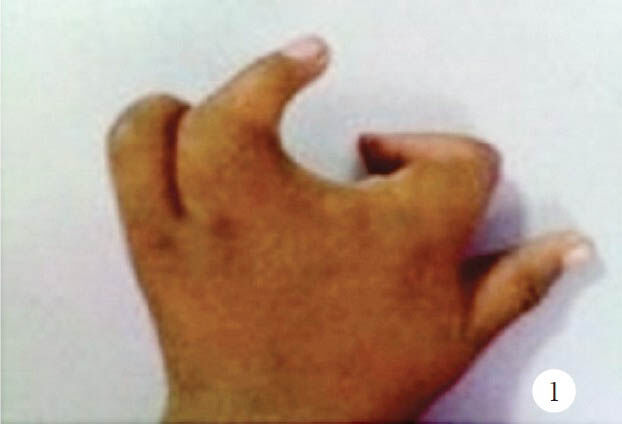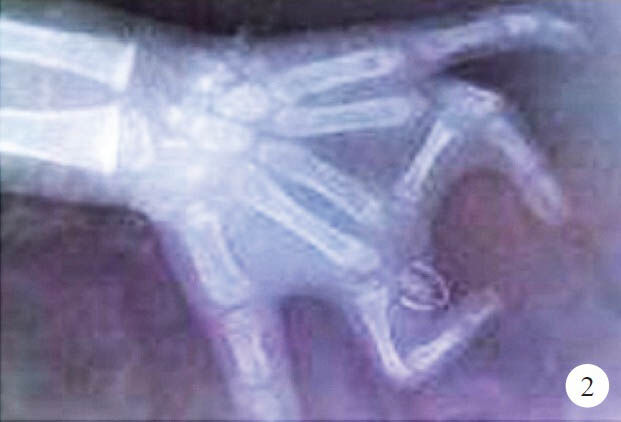Translate this page into:
Unilateral cleft hand (lobster-claw deformity)
+ For correspondence: ashmar1980@gmail.com
This is an open-access article distributed under the terms of the Creative Commons Attribution-Noncommercial-Share Alike 3.0 Unported, which permits unrestricted use, distribution, and reproduction in any medium, provided the original work is properly cited.
This article was originally published by Medknow Publications & Media Pvt Ltd and was migrated to Scientific Scholar after the change of Publisher.
A five year old female child presented to the Department of Orthopaedics, BPS Government Medical College, Sonepat, Haryana, India in June 2012, with deformity of left hand since birth. The left hand had a large median cleft with an absent middle finger and flexion deformity of the index and ring finger (Fig. 1). The right hand and bilateral feet were also normal. Radiograph of hand showed transversely oriented bone between third and fourth metacarpal, third metacarpal was present but phalanges of middle finger were absent except for rudimentary proximal phalanx (Fig. 2). Other than this, no other congenital anomalies were present. The child was born out of a non-consanguineous marriage with a normal perinatal and family history. Surgery involved complete excision of transverse bone with partial excision of the third metacarpal plus apposition of the second and fourth metacarpal by absorbable sutures leading to a decreased cleft (Fig. 3a and 3b). Flexion contracture of index and ring finger was helpful in pinch and grasp and would be corrected later, if required.

- Left hand (dorsal view) shows a median cleft and flexion deformity at proximal inter-phalangeal joints in the index and ring finger.

- Radiograph of left hand shows a transversely oriented bone between third and fourth metacarpal, third metacarpal was present but phalanges of middle finger were absent except for rudimentary proximal phalanx, carpals were normal.

-
a. Postoperative photograph of left hand (dorsal view) showing a decreased cleft. b. Postoperative radiograph of left hand with an excised transverse bone and third metacarpal (partial).
Cleft hand, lobster claw hand and ectrodactyly are different names given to central deficiencies of the hand due to longitudinal failure of formation of 2nd, 3rd or 4th ray. It has an incidence of 1 to 4 in 100000 live births1. Associated anomalies include tibial aplasia, mental retardation, ectodermal defects, orofacial clefting and deafness2. Treatment is surgical correction for function and/or cosmoses.
References
- Congenital limb anomalies: Frequency and etiological factors. J Med Genet. 1974;11:221-33.
- [Google Scholar]





